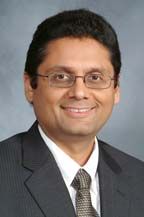Clinical Oncology News summarizes findings from several recently published, important studies and then asks clinicians from top cancer centers to offer their perspectives. Cancer centers are chosen based on reputation, availability and regional diversity, and the journal seeks to have a mix of academic institutions and regionally important hospitals with expertise in cancer care. This month they introduced NewYork-Presbyterian/Weill Cornell Medical Center, and featured commentaries from Manish Shah, M.D., and Peter Martin, M.D. Read the complete issue here.  The Sandra and Edward Meyer Cancer Center at Weill Cornell Medical College and the Ronald P. Stanton Clinical Cancer Program at NewYork-Presbyterian/Weill Cornell Medical Center, in New York City, work to ensure that patients have immediate access to emerging therapies in a supportive and caring environment, while training future researchers and recruiting leaders in cancer research and clinical care.
The Sandra and Edward Meyer Cancer Center at Weill Cornell Medical College and the Ronald P. Stanton Clinical Cancer Program at NewYork-Presbyterian/Weill Cornell Medical Center, in New York City, work to ensure that patients have immediate access to emerging therapies in a supportive and caring environment, while training future researchers and recruiting leaders in cancer research and clinical care.
From Bench …
State-of-the-art research space as well as critical technologies at the new $650-million Belfer Research Building and across campus are empowering nearly 250 doctors and scientists to conduct groundbreaking research that is then brought into the clinic to benefit patients.
“To figure out how to use these new drugs, you need basic scientists, clinicians and molecular pathologists all working together as a team to identify the targets, and, importantly, to then develop biomarker-driven clinical trials,” said Dr. Cantley, who also is the Margaret and Herman Sokol Professor in Oncology Research and a professor of cancer biology in medicine at Weill Cornell.Since joining Weill Cornell in 2012, Meyer Cancer Center Director Lewis Cantley, PhD, has advocated using a “team science” approach to identify new drug targets, with the goal of rapidly translating these discoveries into clinical trials. He has organized the Meyer Cancer Center into five disease-based research programs (Breast Cancer, Lung Cancer, Brain Cancer, Prostate Cancer and Hematologic Malignancies); four science-based research programs that cross multiple diseases (Tumor Microenvironment, Cell Biology and Signaling, Cancer Metabolism, Cancer Genetics and Epigenetics); and one population science research program (Cancer and Obesity).
… to Bedside
David Nanus, MD, the chief of the Division of Hematology and Medical Oncology, leads the center’s clinical program, which delivers comprehensive care to each patient based on his or her unique circumstances. Patients receive the best available evaluation and treatment, whether that is through standard care or participation in an innovative clinical trial. From rehabilitation medicine and fertility preservation to pain management and nutrition counseling, NewYork-Presbyterian/Weill Cornell Medical Center offers patients a diverse range of resources to complement their cancer care.
Rather than offering traditional one-size-fits-all medicine, oncologists at Weill Cornell Medical College and NewYork-Presbyterian Hospital use genomic sequencing tools to search a patient’s entire genome and locate the specific genetic alterations that have given rise to and are driving his or her tumor. Armed with this information and the patient’s medical history, they can identify specific drugs, vaccines and other therapies that are precisely targeted and are, therefore, most effective and have the fewest side effects.
“Utilizing precision medicine, we are at the tipping point for breakthroughs in targeted therapy in which you develop treatments that hit the very gene, or gene product, that is driving the cancer,” said Dr. Nanus, who also is the Mark W. Pasmantier Professor of Hematology and Oncology in Medicine and a professor of medicine and of urology at Weill Cornell.
By bridging the work of scientists and clinicians, the Meyer Cancer Center and Stanton Clinical Cancer Program are converting conceptual breakthroughs into advanced patient therapies.
Peter Martin, M.D.
 Peter Martin, M.D.
Peter Martin, M.D.
Standard therapies for Waldenstrom’s macroglobulinemia have always seemed a little unsatisfying. Cytotoxic chemotherapy is effective, but often is overly aggressive for an indolent lymphoma. Moreover, in a population with a good prognosis, the risk for secondary malignancies and an increased rate of aggressive transformation justify consideration. Anti-CD20 antibodies can be effective, but responses are slow and of modest duration, and they are often accompanied by transient flares in serum IgM concentration. Proteasome inhibitors have fewer long-term side effects than DNA-damaging drugs, but peripheral neuropathy can be problematic in a group of patients for whom disease-related neuropathy is already an issue.
In January 2015, two years after the oral BTK inhibitor ibrutinib received a breakthrough therapy designation from the FDA, patients and clinicians were elated to learn that the agency had expanded the label to include Waldenstrom’s macroglobulinemia, already approved for mantle cell lymphoma and chronic lymphocytic leukemia. The Phase II trial on which approval was based (N Engl J Med 2015;372[15]:1430-1440, PMID: 25853747) illustrates why the news was so eagerly anticipated. In addition to inducing a high response rate that appeared to be durable, ibrutinib was well tolerated. Few patients came off study due to adverse events; IgM flare did not occur; patients with neuropathy experienced subjective improvement; and rates of transformation and secondary neoplasms were low, although follow-up was relatively short.
After the approval of any therapy, new questions arise. Should genetic testing become standard in this disease, and where will patients get those tests done? When should lifelong continuous ibrutinib replace a less expensive and much shorter course of rituximab (Rituxan, Genentech) or the even less expensive alternative, observation? Are there new therapies or combinations that might be better or cheaper? In a disease with an annual incidence of approximately 1,500 new diagnoses, answers are likely to be slow in coming. It will be up to the community of researchers to collaborate more closely than ever to come up with solutions.
Manish Shah, M.D.

Advanced gastric cancer is a global disease, with significant variation in disease subtypes and treatment paradigms around the world. In most places, AGC is treated with combination chemotherapy in the first-line setting, typically with a platinum and fluoropyrimidine backbone, such as cisplatin/capecitabine, as was used in numerous registration studies, or FOLFOX (folinic acid, fluorouracil and oxaliplatin) chemotherapy, which is perhaps better tolerated and considered equally efficacious.
Second-line chemotherapy for AGC also now is a standard care option, with multiple clinical trials now demonstrating a benefit of single-agent chemotherapy over best supportive care. The present study, by Nishikawa and colleagues, examines the role of combination chemotherapy in the second-line setting versus monotherapy. The study was unique in that patients received only S-1, an oral fluoropyrimidine, in the first-line setting. As such, proceeding with a second-line doublet would be anticipated to improve survival. Surprisingly, in this relatively small study of 168 patients, single-agent irinotecan was equivalent to the irinotecan/cisplatin doublet. This suggests that single-agent therapy is truly a standard second-line strategy, and that combination therapy is unlikely to be useful, even in the West. This affords an opportunity for targeted therapies, as we have seen with the use of ramicirumab (Cyramza, Lilly) in the second-line setting.






